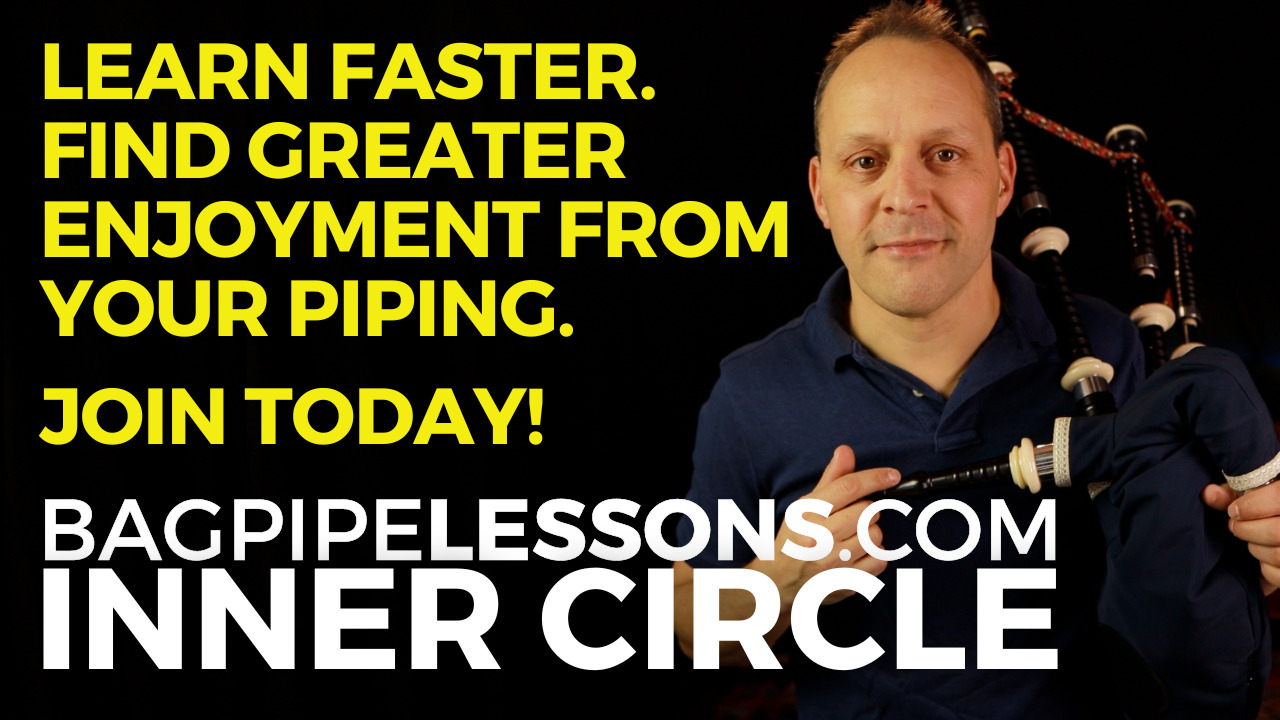
AS FEATURED IN

Bagpipe Drone Reed Secrets Revealed: The Ultimate Guide to Master your Bagpipe Sound
by Jori Chisholm, Founder of BagpipeLessons.com
Last Updated: November 28, 2023
Watch the video and scroll down to read the full video transcript.
Video Transcript: Hi, I’m Jori Chisholm. Today, we’re going to talk all about bagpipe drone reeds and why the right set of reeds is super important, not only for your overall bagpipe sound, but for how your pipes feel when you play. We’ll look at some of the best modern drone reeds, and we’ll compare them to the traditional cane drone reeds of the past. We’ll learn how to check if your drone reeds are still good or if it’s time to upgrade to a new set. Finally, I’ll share my top picks for the best new drone reeds out there, including my all-time favorite set, and how you can get a set for yourself.
Check out BagpipeLessons.com where you’ll find the inspiration and knowledge to fulfill your piping dreams. Pipers know that to play your best, your pipes need to sound and feel great. A lot goes into achieving that:
- You need the right equipment.
- You need to make sure it’s properly set up and maintained.
- You need to master steady blowing.
- You need to practice enough to stay in shape.
One of the most important factors that help you achieve a great bagpipe sound is a great set of drone reeds that works properly with your pipes. The good news is that today, there are lots of excellent drone reed options out there that can help you achieve that warm, smooth, and full sound that’s stable, efficient, and easy to tune.
The first modern drone reeds became widely available in the early 1990s, and compared to traditional cane reeds, they have some very clear advantages. Here we have a traditional cane drone reed. Let’s take a up-close look at a traditional cane drone reed and see how it works.
The cane reed is a hard tube that comes from the stem of plants in the grass family like bamboo. The cane reed is a piece of cane cut to length, sealed on one end with sealing wax, similar to the wax used to seal letters in the past. There’s a waxed hemp bridle which is tied around the reed. Then the reed maker uses a sharp knife to make a cut and split the cane, which forms the tongue that vibrates to create the sound the drone produces.
Now let’s compare a modern Ezeedrone reed and how it works to create the distinctive drone sound. The standard Ezeedrone tenor reed follows the same basic design but uses modern materials and has some additional features. It consists of a tube machined from a synthetic material like plastic. The tongue is made from a different material, in this case, a clear plastic. And the bridle, instead of waxed hemp, is rubber. When you blow on the reed, it vibrates the tongue and creates the sound. Most modern drone reeds also offer a way to adjust the length of the drone reed, which allows you to adjust the pitch. This Ezeedrone reed has a tuning screw that makes it easy to change the length of the reed by screwing it in to shorten the reed, therefore raising the pitch, or unscrewing it to lengthen the reed to lower the pitch.
Traditional cane reeds have their own set of challenges, making them difficult to work with. Cane is a natural material; each piece varies in size, shape, thickness, and hardness. Additionally, since they’re handmade, every reed is different. Even the most skilled reed makers can’t produce them identically every time. There can be significant variability between reeds. I remember having to order dozens of cane reeds just to find one set that worked well in my pipes.
The most significant issue with cane drone reeds is their sensitivity to moisture. The unpredictability of cane drone reeds makes them risky to play. You never know when your reed might stop working. I remember my first time visiting Scotland on a family trip. I had the opportunity to watch the prestigious Gold Medal Competition at Oban. This was back in the mid-90s when most players were still using cane drone reeds. Several pipers had drones stopping during their performances. This is caused by the drones getting too wet and shutting off. In most cases, the player would stop playing since they were essentially disqualified. To continue to play would be considered disrespectful of the judges and the audience. I remember one famous piper who said, “When your drone stops, so should you.” These days, it’s extremely rare to see a piper’s drone shutting off during a competition, even at the beginner levels. This is primarily due to the global shift towards modern drone reeds, which offer better consistency, ease of playing, and greater stability.
Adjustment and resistance to moisture and humidity are important factors for modern drone reeds. While there are still a few players in the world who use cane drone reeds, most have moved on to modern reeds for their steady, consistent sound and ease of tuning. The best sounding bagpipes of all time are being played today by the world’s top pipers, and they’re using modern drone reeds, zipper bags, moisture control systems, and Tone Protectors.
A high-quality set of modern drone reeds will perform well right out of the box. However, they do not last forever. All drone reeds will eventually wear out and will need to be replaced. Pipers often ask me, “How long do drone reeds last?” But that’s not the right question to ask. The right question is, “How long do drone reeds play like new?” The answer is: modern drone reeds can play like new for several months to a year, depending on how much they are played and how well they are maintained. How long your drone reeds last depends on the conditions you play in, the type of pipe bag and moisture control system you use and how often you play your pipes.
I know some pipers who get a new set of drone reeds every year to keep their pipes sounding in top form. If you enjoy playing and play regularly, and you want your pipes to sound great, stay in tune, be comfortable and efficient, check your drone reeds. Consider getting a new set every year or two as an investment in your playing quality and enjoyment.
If you want a good sound and pipes that are comfortable to play, your goal shouldn’t be to make your reeds last forever. Instead, your goal should be to have reeds that sound and play like new, allowing you to focus on the execution and expression of your music and enjoy playing. So, how do you know when it’s time to replace your drone reeds?
The best modern drone reeds might take a little adjustment to get set up initially, but once they’re working for you, they should operate consistently for a long time with very little further adjustment or maintenance. So, you’ll want to take notice of any changes in how your reeds sound or feel. If your drones have been consistent for a long time, then things start to change, for example: if you find yourself adjusting the bridles or tuning screws, or if your pipes start to lose their stability, it’s a sign that your drone reeds could be starting to go. Here are some signs to look for that your reeds are on their way out:
- Are they going out of tune?
- Are they less stable to pressure changes?
- Are they hard to get in tune?
- Are they taking too much air?
- Are the drones shutting off when you play?
- Is the bass drone becoming hard to strike-in, double-toning or roaring?
- Does a tenor drone whistle or squeal?
- Are you getting trailing drones when you cut off?
- Are your drones tuning too high or too low on the pin?
If you notice any of these issues, it might be time for a new set of drone reeds. Do a visual inspection of your reeds. How do they look? Visually inspect your reeds: color, residue, bridles. If you’ve been playing for more than a couple of years, you probably have some old drone reeds lying around. You might even have a whole box of them, like I do. Ask yourself these questions while inspecting your reeds: Do they look dirty, discolored, or cracked? Look especially around the tongue and the bed of the reed where the tongue sits. Ezeedrone reeds have this clear tongue, and you can often see discoloration, cloudiness, or residue that builds up over time. Check the bridle: it should be tight and not easily move or wiggle. The rubber band or O-rings can get hard over time and lose their springiness or crack. How about the tongue? Take a look at your reeds and compare them to what they looked like when they were new.
Some reeds have the option to replace parts of the reeds. Some parts can be replaced: the bridles if they’re loose or cracked, and some reeds have tongues that can be removed and replaced.
I’ve heard of some pipers who take their reeds apart and wash them, and then put them back together. Based on my experience, the improvements that you get from replacing the tongues or bridles, or cleaning your reeds are pretty minimal and will be temporary in terms of improving the sound and efficiency of your drones. You’re better off getting a whole new set of reeds.
Next, take your pipes apart and blow the reeds in the drone. Now you’re listening for something very specific – two distinct tones. If the reed is healthy and happy and a good match for your pipes, you should get those two tones. The first tone occurs when you blow softly, and the second tone appears as you increase the pressure when you’re playing your pipes. When you strike-in lightly on the bag, you get that first tone, and then when you bring the pipe chanter in, the drones kick into the second tone.
Can’t get two tones? Something is wrong with your reed or your pipes. Either the reed needs to be replaced, it needs adjustment, or the combination of that reed in your pipes is not a good match. The second tone should not be louder. Now there’s something very important that you want to listen for. Ideally, you want the second tone to be equal in volume or slightly quieter than the first tone. This indicates that the reed is functioning at its best and is well-suited for your drone. If you can’t get the two tones or if the second tone is louder than the first, it’s a guarantee that that reed is unstable and taking too much air. You want a smoother, more focused second tone.
A good reed is efficient and stable. You can test the reeds by varying the blowing pressure to listen for steadiness, there will be very little or no change in pitch. This is fantastic as it makes your pipes easy to tune and they’ll stay in tune even if your blowing isn’t perfectly steady. A problematic drone reed will make a single tone or the second tone is louder than the first. The reed is unstable, so when you vary the blowing pressure, you can really hear the pitch go up and down. They’ll make you sound worse than you are since any minor pressure changes from blowing will be magnified, making your drone sound really unsteady.
How old are your reeds? One or two years means you got your money’s worth. Consider the age of your reeds. If you’ve been playing your reeds consistently for more than a couple of years and they’re still working great, that’s wonderful. You might be able to get some more playing life out of them. However, keep in mind that reeds are at their best when they’re new. They can remain really good for a long time, but the reliability and stability will gradually decrease over time. This can be very subtle, making it difficult to notice. So, if you’re playing a well-loved, battle-tested set of reeds for a couple of years or more, I’d say you’ve definitely got your money’s worth on that set of reeds. You should consider a new set. At the very least, you want to have a spare set in your pipe case for when you need them.
If you’ve decided to explore some options for a new set of drone reeds, you’re in luck! There are some fantastic options available that will help your pipes sound great and be easy to play. Let’s look at a few options, and then I’ll show you my number one most favorite set of all time.
Ezeedrone Drone Reeds and Selbie Drone Reeds Comparison – my two favorite brands.
Ezeedrone and Selbie – you can see they’re quite similar in their overall design. They have very similar dimensions, a small tongue, a rubber band bridle, and a tuning screw. Ezeedrones have a brown body with a clear plastic tongue, while Selbies have a white body with a black tongue.
Up-Close look at Selbie Reeds
Selbie reeds are made in Scotland and they’re known for being exceptionally steady, smooth, and air efficient in modern and old bagpipe models. In my experience, they offer a truly plug-and-play experience, requiring little or no adjustments. Just put them in, and they sound and feel great. Selbie recently redesigned the bass reed for a richer, fuller, and steadier sound. The tongues are injection-molded from a black plastic material, and they are removable due to this unique T-joint attachment. It’s curved, and it has a very interesting texture on the bottom. I think that’s one of the secrets of the Selbie sound. It has a tuning screw with a locking nut, so you can lock it into position. These transparent silicone bridles make it really easy to move and fine-tune the bridle position easily.
Up-Close at Ezeedrone Reed Sets
Ezeedrones are the most well-known, most popular and trusted brand of drone reeds in the world. They’ve been around for a long time and they’re extremely consistent in their manufacturing and quality control. They have several different models but the most commonly played set is the Standard Set which includes the bass and two tenor reeds. It’s got the classic dark brown Ezeedrone color with the clear tongue and the black rubber bridle. Another option is the Standard Set with an Inverted Bass Reed. On the Inverted Bass Reed, the tongue is reversed. In some sets of pipes, the Inverted Bass Reed is a better choice. The Inverted Bass Reed can be steadier, is easier to strike-in, has a mellower sound, and takes less air. If you’ve ever had a problem striking-in your bass drone, or issues with your bass drone in general, an Inverted Bass Reed might be a great option. Ezeedrone recently released a new set of reeds that’s an updated version of their trusted design but made with a different material that has increased moisture absorption. The idea is that any moisture that builds up on the reeds will be absorbed into the reed body instead of building up on the reed and making them go out of tune. This Increased Absorption set has an Inverted Bass Reed that is superb, more on that in a minute. If you play with a natural leather bag, or you play without a moisture control system, you might want to try the Ezeedrone Increased Absorption set. With all these great options, you’ll find the right set for you. I’m going to tell you which set is my absolute favorite, but first let me share a short story.
Jori’s Never Ending Quest for the Ultimate Set of Bagpipe Reeds
Anytime I hear a piper with a great sound, I’ll ask “Hey what’s your setup these days? What reeds are you playing?” A few years ago I asked those questions to some world-class pipers and several of them told me they were using the newer Ezeedrone Bass Reed with the Increased Absorption material. My response was, “Wow. Okay, great. But I use a Bannatyne hybrid zipper pipe bag and the dry flow moisture control system, so my drone reeds never get wet. Why would I need the Increased Absorption Reed?” They all told me the same thing: “The new reed is better, it’s steadier, richer ,and more resonant. It’s the best bass drone in the world.” The best bass drone reed ever? I asked again, “What about the tenor drones?” Again they all told me the same thing. They preferred the standard older style tenors. Of course I wanted to figure this out for myself
So I got a bunch of different Ezeedrone combinations of reed sets and I tested out all of the different combinations over several months in different playing conditions. I tried the variations of the bass and tenor reeds. My discovery was the best set of reeds I’ve ever played.
I discovered what I consider the very best combination of drone reeds I’ve ever played: the newer design Ezeedrone Bass Reed with Increased Moisture Absorption and the regular style Ezeedrone Tenor Reeds. THIS combination provides the perfect balance of sound steadiness and efficiency making it my top choice for drone reeds.
Give it a try and you may discover that it’s the ideal set for you too. I have recommended this to many of my students and piping friends. Some play new pipes, some play old pipes, all different makes. This set sounds fantastic together. These reeds blend seamlessly with the perfect balance of bass and tenor and your chanter. They’re extremely efficient and rock steady. I was surprised how easy they are to tune. The Sweet Spot is super obvious so they lock in easily.
So I reached out to the nice folks at Ezeedrone to ask if they would make me a custom set with this combination of the newer style base and the standard tenors. They agreed and now you too can get this exclusive Ezeedrone Combo set yourself, it’s called the Ezeedrone Combo Set. It’s available from my BagpipeLessons.com shop at BagpipeLessons.com/dronereeds.
My shop is the only place in the world you can get these reeds in a single set so if you’re looking to replace your trusted but old worn-out drone reeds, or if you want to upgrade your pipe sound and efficiency, or if you just want to try a different set to see how it works for you, check out the BagpipeLessons.com Shop at BagpipeLessons.com/Shop where I’ve got links to all these great drone reeds.
I guarantee that you will love these sets. They’ll make your pipes easier to play, easier to tune, and help you achieve that rich sweet resonant steady bagpipe sound that you deserve so you can enjoy playing more and focus on your tunes. We love to play our pipes, and you know you love to play even more when your pipes sound and feel great. So check out the shop and see if it’s time for an upgrade.
More Videos
More Videos

Free Drone Reed Setup Guide!








